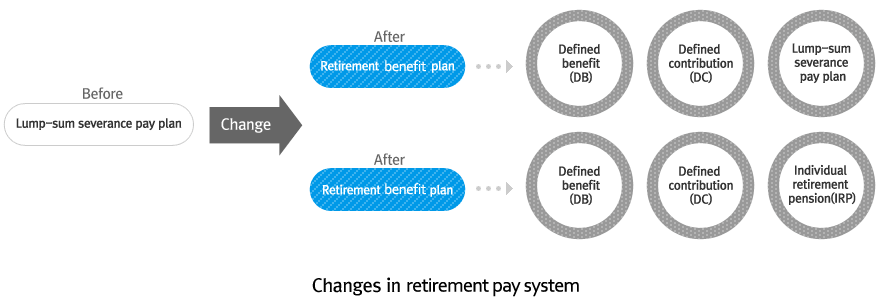Change in Retirement Pay System
The current retirement pay system, which was introduced 40 years ago, has not properly reflected social changes hitherto. Frequent job quitting, early settlement of retirement allowances, and early retirement make severance pay be spent just as a living cost, leaving little for a later life income. On the other hand, the retirement pension plan, introduced after December 2005, has properly reflected the rapid social and economic changes, helping workers enjoy a better later life.

Lump-sum severance pay plan vs. Retirement pension plan
Lump-sum severance pay plan
- Since July 26, 2012, the early settlement of severance pay has been banned.
available only for a house purchase for non-home, house rental, over 6 months of medical treatment, bankruptcy and personal revival - Severance pay is given as a lump sum, leading it to be spent just for living expenses, and leaving little for a later life income.
- The company reserves severance pay, so when it goes bankrupt, the system cannot protect employees’ right to claim benefits.
- Debts on severance pay are difficult to forecast, increasing the company’s burden of shouldering lump-sum payment.
Retirement pension plan
- Better benefit eligibility
- Retirement benefits are reserved in a reliable financial institution and the benefit eligibility for employees is secured
- Various ways to receive retirement benefits
- Employees can receive retirement benefits as a lump-sum allowance or a pension.
- Aggregation of retirement benefits
- Regardless of job transfers, employees can reserve retirement benefits while enjoying tax deferrals on their retirement income tax before retirement.
- Taxable income reduction
- Availability of taxable income reduction on additional reserve by employees: Up to KRW 7 million including pension savings (as of 2015)
- Tax-free investment profits during reserve period
- Tax-free : Investment benefits from retirement pension are not taxed (tax deferrals)
- Tax deferral on retirement income
- Retirement income tax is deferred until employees receive retirement benefits, thus increasing real income.















